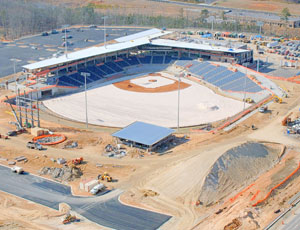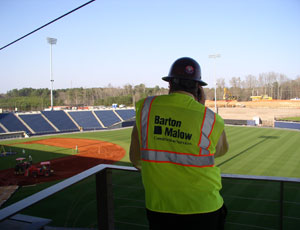When fans sip their first beer at Atlanta’s new minor league ballpark on April 17, few of those on hand will appreciate the feat of design and construction that led to the opening day event.
The new $59-million facility on 12 acres in Gwinnett County, northeast of Atlanta, was designed and built in just over one year. The secret to the fast delivery was a method called design—build/assist, where the design team provided the vision, oversight and schematic phase drawings, but major subcontractors provided the detailed design. This approach allowed the team to tap the hands-on experience of key subcontractors on materials and methods, and moved the project forward without lengthy design-phase deliberations.
The approach might be unusual in some circles, but the results speak for themselves.
The owner, Gwinnett County Convention and Visitors Bureau, was able to lure the Richmond, Va., Braves, an AAA-level minor league team to the county. The Braves organization, whose major league team plays in Atlanta, got a state-of-the-art minor league facility close to its major league home. And the 10,200-seat ballpark is coming in on time and on budget.
The $59-million price tag is above that of other recent AAA ballparks across the country, which average in the range of $30 million to $40 million, but the ballpark has amenities typically found only in major league stadiums. These include 22 luxury suites, office space for the Braves organization, a number of amenities for fans and sophisticated digital broadcast and production facilities designed by veteran Atlanta Braves broadcast engineer Chip Graham.
The construction team didn’t get started all that long ago.
Construction Manager Barton Malow, based in Southfield, Mich., and designer HKS Inc., Dallas, signed an initial contract with the owner in early March, 2008. Foundation work started in late April, 2008. By August structural steel was going up. Working 15-hour shifts almost seven days a week since then, the ballpark is on target for its April 17 opener.
“Usually we like to see six months of design before we start digging,” says Project Architect Matt Mitchell, an associate in the Atlanta office of HKS. Instead, the conceptual design phase was compressed to about two months. The design-build project team had a series of early meetings with all stakeholders, he says, and it was a “speak now or forever hold your peace situation.”
“A lot of the early design decisions were done on instinct,” adds Mitchell, based on years of sports experience among team members. With those key decisions set, initial foundation and structural work got underway, and later phases of the design were planned out. “Those initial decisions were validated as the construction went along. That took a lot of pressure off the team; after that there wasn’t a lot of drama or second guessing.”
Another factor that cut through the potential fog of fast-track, design-build delivery was an emphasis on clear lines of communication. “Early on we identified who the ‘final’ decision-makers were for each team member,” says Phil Roy, vice president of the Atlanta office of Barton Malow. “That was crucial—it cut out a lot of confusion.”
Significantly, both the county’s owner representative and project architect Mitchell were on site throughout construction.
“This was the ideal way you’d want a design-build project to run,” says Doug Steljes, Barton Malow’s project executive.







































Post a comment to this article
Report Abusive Comment